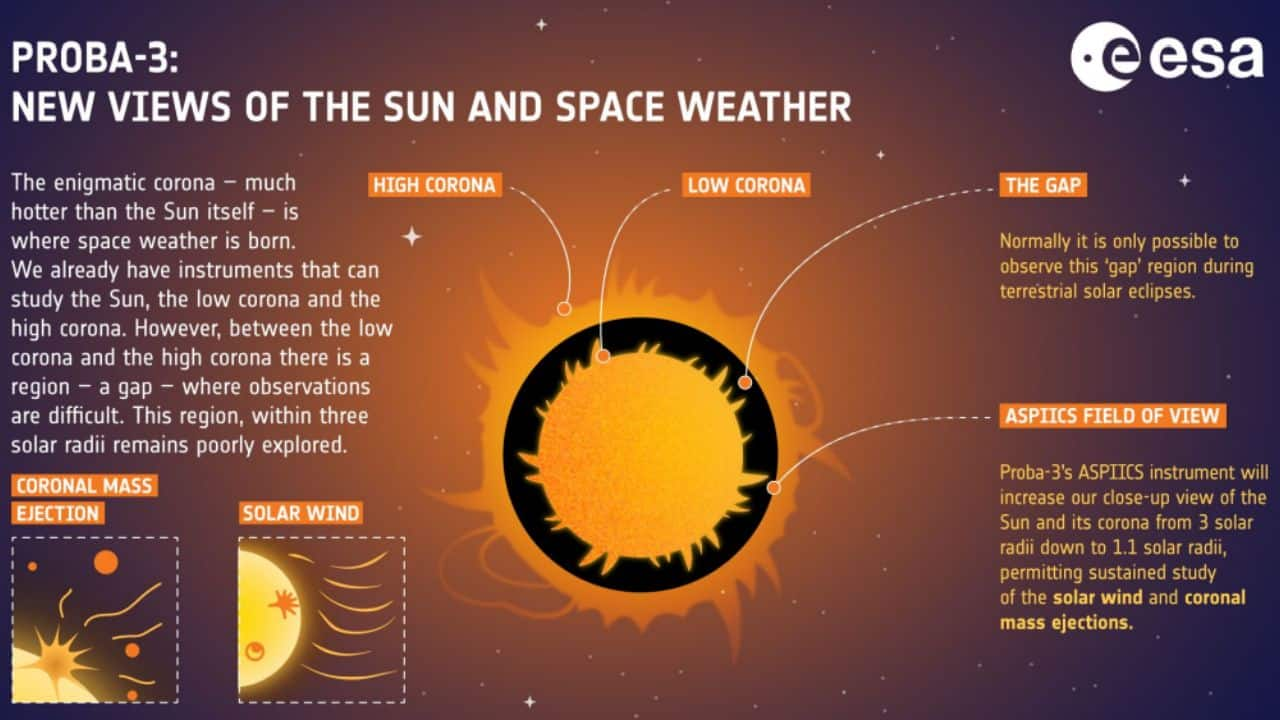



The Indian Space Research Organisation (ISRO) on Thursday successfully launched the PSLV-C59/PROBA-3 mission, an innovative and groundbreaking effort to study the Sun's outer layer, the Corona, through a unique approach.
Proba-3 is a precision formation-flying mission involving two satellites —Coronagraph (310kgs) and Occulter (240kgs)— flying extremely close to each other, about 150 meters apart, to mimic a solar eclipse that will last for six hours. The mission's primary aim is to explore the unexplored gap between the inner and outer radii of the Sun's corona.
 Image: European Space Agency
Image: European Space Agency
The Sun's corona, its outermost layer, has been challenging to study because its intense brightness makes observation difficult. This faint and extremely hot layer is the origin of solar wind and solar storms. The only way to observe it is during a total solar eclipse or using specialized telescopes that block the Sun's light.
In this mission, the Occulter satellite blocks the Sun’s light with a 1.4-meter-wide disk, while the Coronagraph satellite observes the corona from the shadow cast by the Occulter. The aim is to replicate a solar eclipse for extended observation, allowing scientists to investigate the faint corona and answer long-standing questions, such as why the corona is hotter than the Sun’s surface. Additionally, the ASPIICS system will study the interaction between the Sun and its atmosphere, as well as Coronal Mass Ejections.
The two satellites will also carry additional payloads- the Digital Absolute Radiometer (DARA), which measures total solar irradiance, and the 3D Energetic Electron Spectrometer (3DEES), designed as a technology demonstration to measure electron spectra in Earth's radiation belt.
To achieve this, the satellites will perform formation flying at an altitude of over 60,000 km in a highly elliptical orbit. While the Sun-Earth Lagrange Points would have been ideal for this mission, the cost of reaching them was too high. Instead, a more cost-effective orbit was chosen, starting at 600 km in altitude and reaching up to 60,500 km during a 19-hour, 36-minute orbit.
The mission is not only crucial for advancing our understanding of the Sun but also for studying solar weather, such as solar storms and Coronal Mass Ejections, which can impact satellite operations and disrupt communication and power networks on Earth.
The Proba-3 mission is expected to last for two years, after which the satellites will gradually re-enter Earth's atmosphere due to gravitational forces from the Sun and the Moon, in compliance with ESA's Zero Debris policy. This process will occur within five years of the launch
Discover the latest Business News, Sensex, and Nifty updates. Obtain Personal Finance insights, tax queries, and expert opinions on Moneycontrol or download the Moneycontrol App to stay updated!
Find the best of Al News in one place, specially curated for you every weekend.
Stay on top of the latest tech trends and biggest startup news.